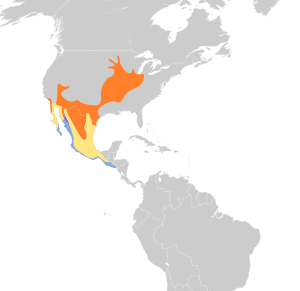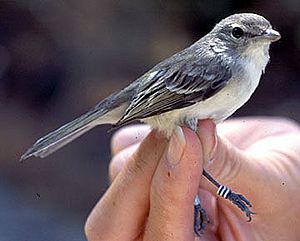Bell's vireo facts for kids
Quick facts for kids Bell's vireo |
|
|---|---|
 |
|
| Conservation status | |
| Scientific classification | |
| Genus: |
Vireo
|
| Species: |
bellii
|
 |
|
The Bell's vireo (Vireo bellii) is a small songbird. It travels long distances, flying from its breeding grounds in North America to its winter homes in warmer places like Central and South America. This bird is mostly dull olive-gray on its back and whitish underneath. It has a faint white ring around its eyes and light bars on its wings.
This bird was named by John James Audubon, a famous bird artist. He named it after John Graham Bell, who joined him on a trip up the Missouri River in the 1840s.
A special type of Bell's vireo, called the least Bell's vireo (Vireo bellii pusillus), lives in Southern California. This subspecies is an endangered bird. This means there are very few of them left. Because of this, plans for building new homes or businesses often have to consider how to protect the least Bell's vireo's home. The main reason for their decline is the loss of their natural riverside homes.
Contents
What Does a Bell's Vireo Look Like?
Bell's vireos are small birds. Here are some of their average measurements:
- Length: About 4.5 to 4.9 inches (11.5 to 12.5 cm) long. That's about the length of a small smartphone!
- Weight: They weigh around 0.3 to 0.3 ounces (7.4 to 9.8 grams). This is lighter than a single AA battery.
- Wingspan: Their wings can spread about 6.7 to 7.5 inches (17 to 19 cm) wide.
Where Do Bell's Vireos Live and What Do They Do?
Bell's vireos often build their nests in thick bushes and shrubs. These include plants like willows, mulefat, California wild rose, mugwort, Fremont cottonwood, and even Western poison oak.
Their nests are very well-camouflaged, meaning they are hard to see. If an intruder gets too close, the vireo will bravely defend its nest. Like many other North American songbirds, Bell's vireos sometimes have a problem with brown-headed cowbirds. Cowbirds are known for laying their eggs in the nests of other birds. This means the Bell's vireo parents end up raising the cowbird chicks instead of their own.
The Least Bell's Vireo: A Comeback Story
In the past, the least Bell's vireo was a common bird. It lived in lowland areas near rivers and streams, from coastal southern California all the way north to Red Bluff. They also lived near streams in the mountains and in places like Owens Valley and the Mojave Desert.
During winter, least Bell's vireos fly to the Baja California Peninsula. In winter, they are not as picky about where they live. They can be found in different places, like scrub areas, palm groves, and even hedges near farms and homes.
By 1986, when the U.S. Fish and Wildlife Service listed them as an endangered species, most of their original homes were gone. There were only about 300 pairs left in California. Most of these birds were found in San Diego County.
However, thanks to conservation efforts, their numbers have grown a lot! In the ten years after they were listed, their population increased six times. By 1998, there were an estimated 2,000 pairs.
Least Bell's vireos have started to return to their old homes. They are now nesting again along the Santa Clara River in Ventura County and the Mojave River in San Bernardino County. The northernmost sighting of a nesting pair in recent years was near Gilroy in Santa Clara County in 1997. Today, about half of the least Bell's vireo population lives on lands within Marine Corps Base Camp Pendleton in San Diego County, especially near the lower Santa Margarita River.
- Lua error in Module:EditAtWikidata at line 29: attempt to index field 'wikibase' (a nil value).
- Interactive range map of Vireo bellii at IUCN Red List maps
- Audio recordings of Bell's vireo on Xeno-canto.
See also
 In Spanish: Vireo de Bell para niños
In Spanish: Vireo de Bell para niños



